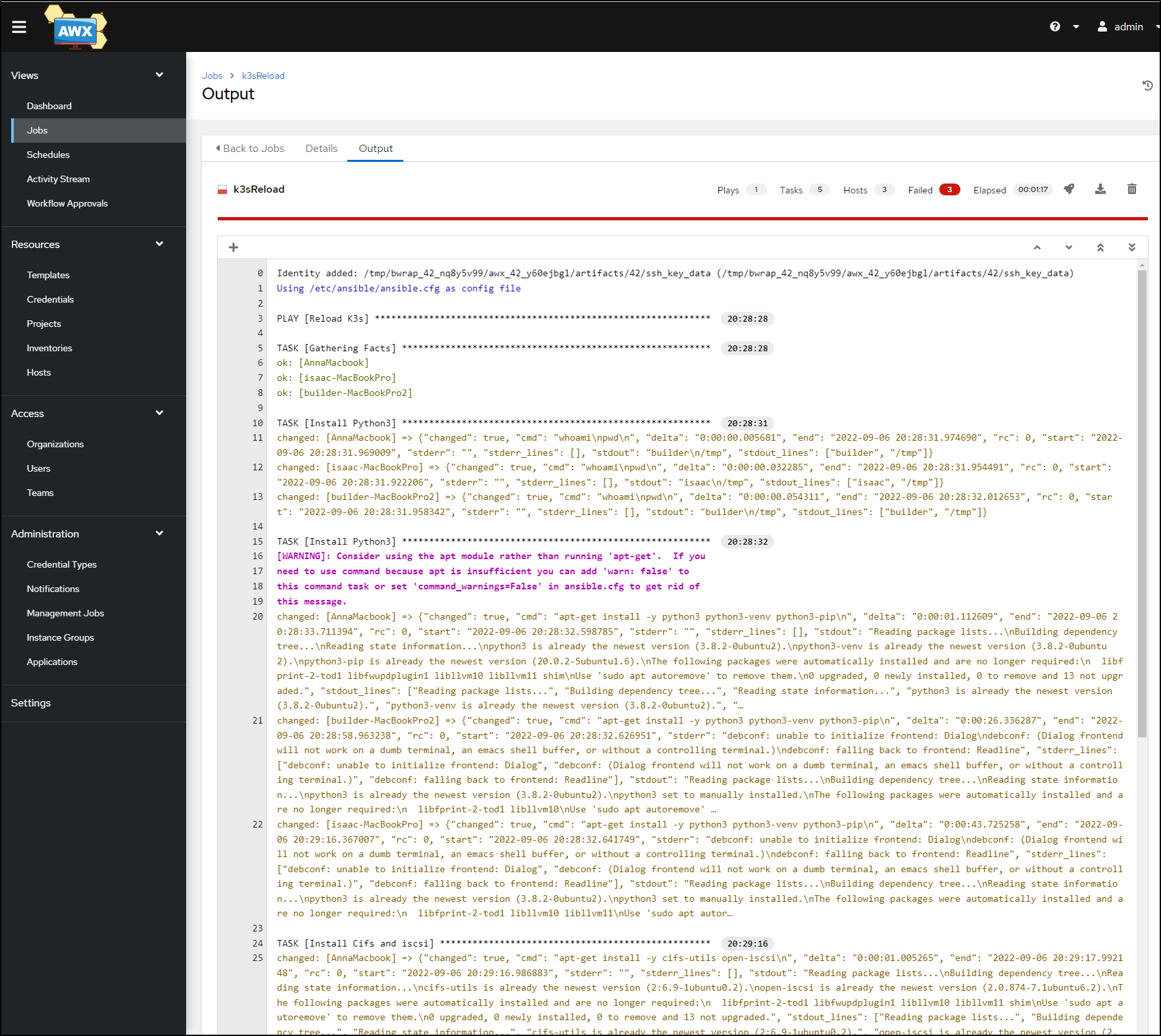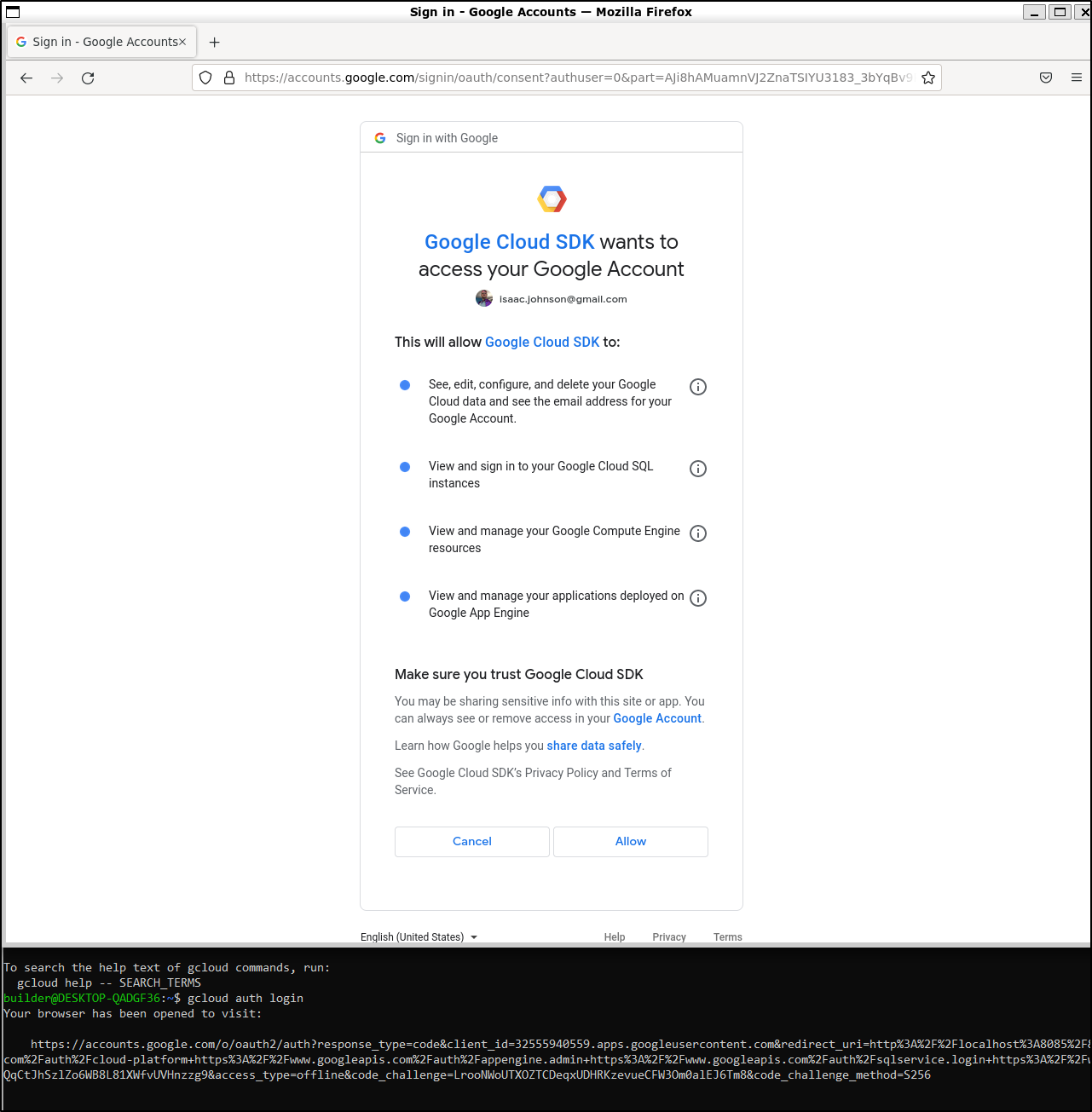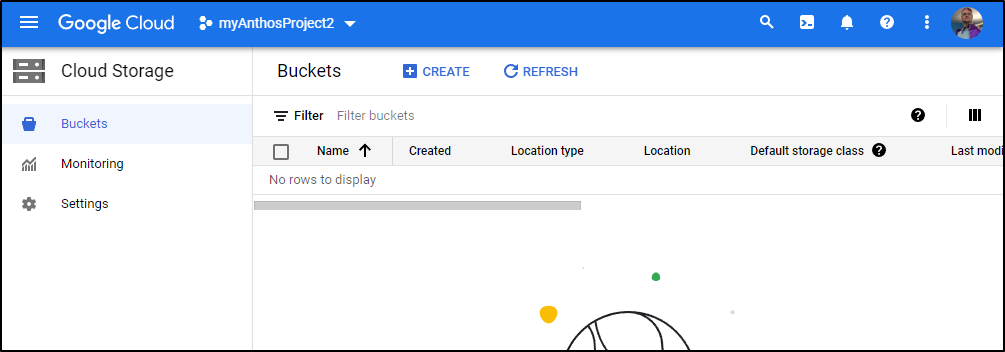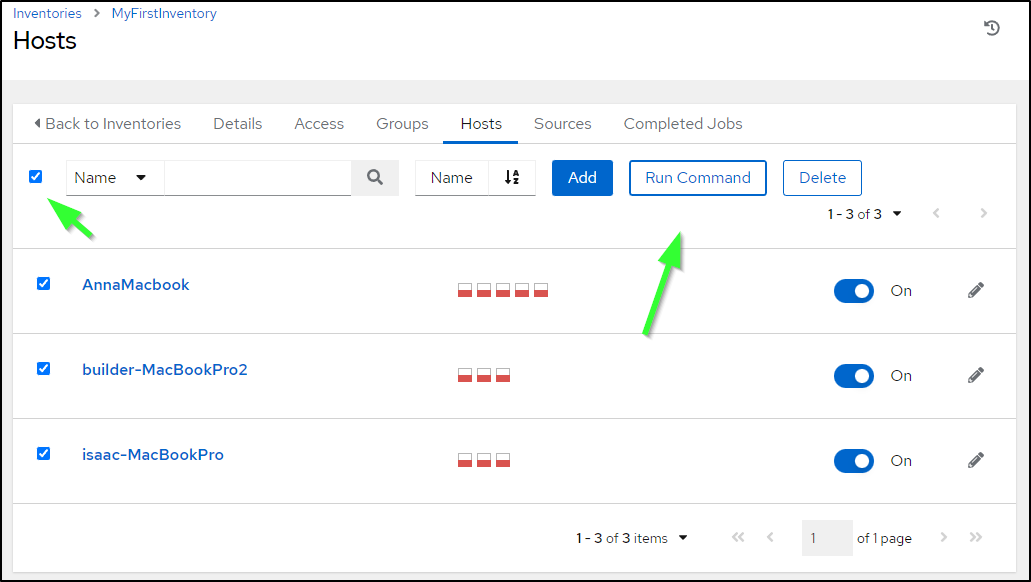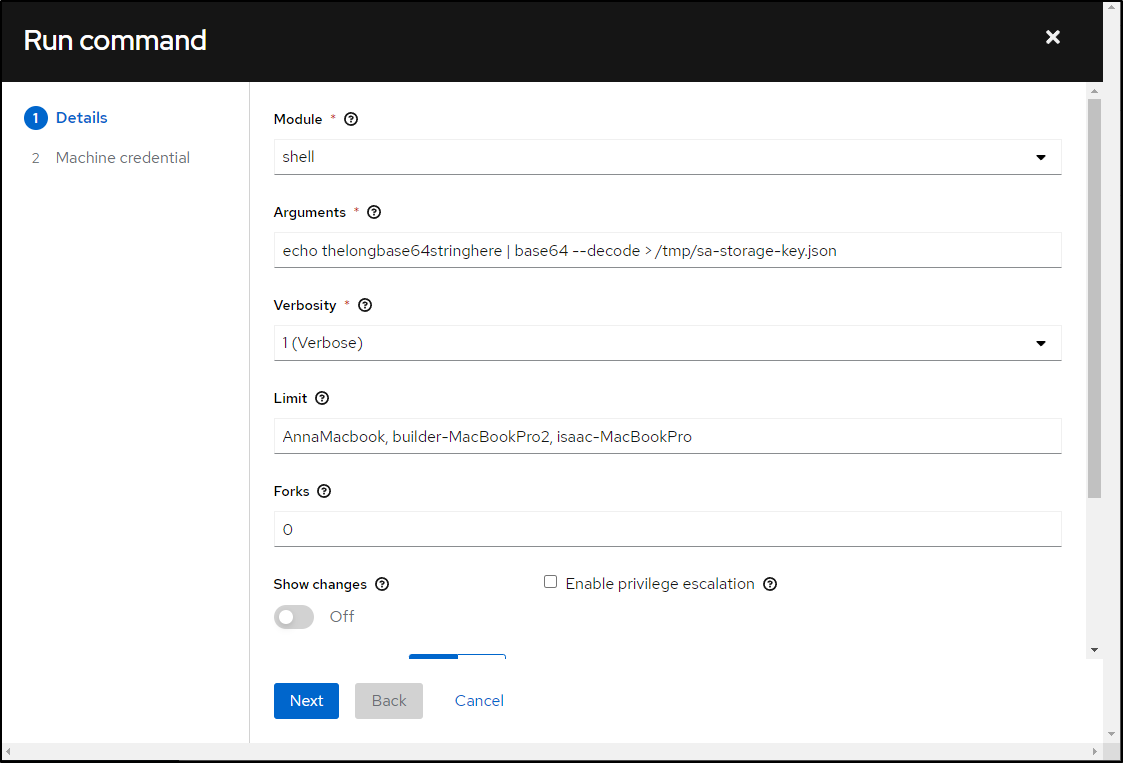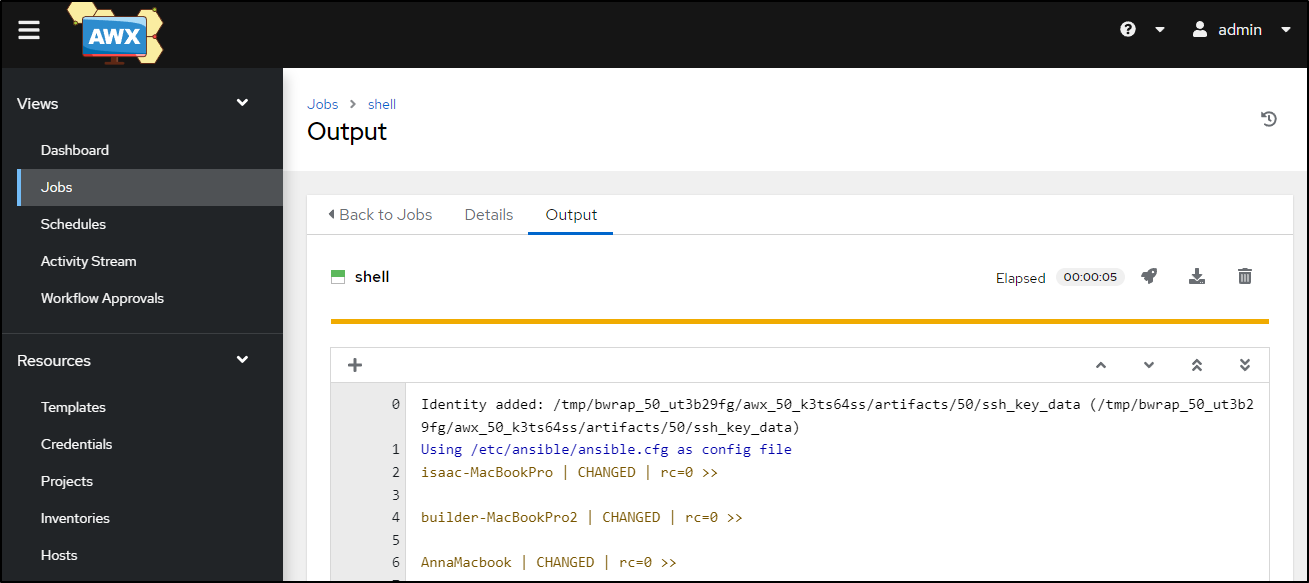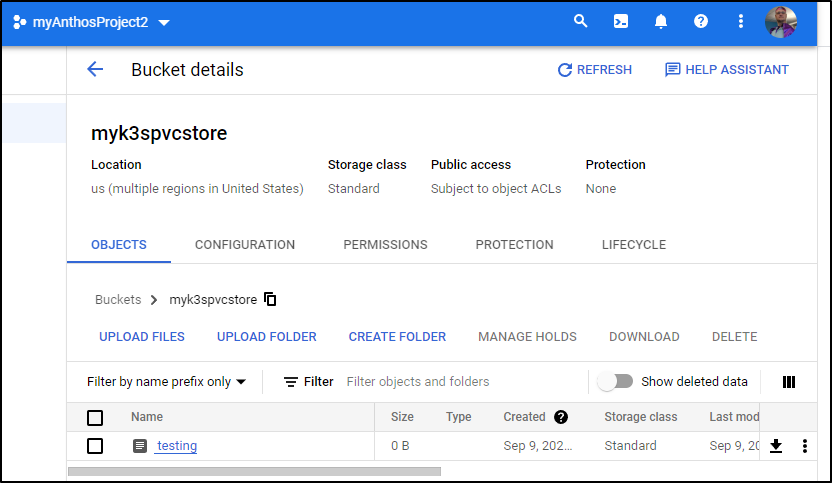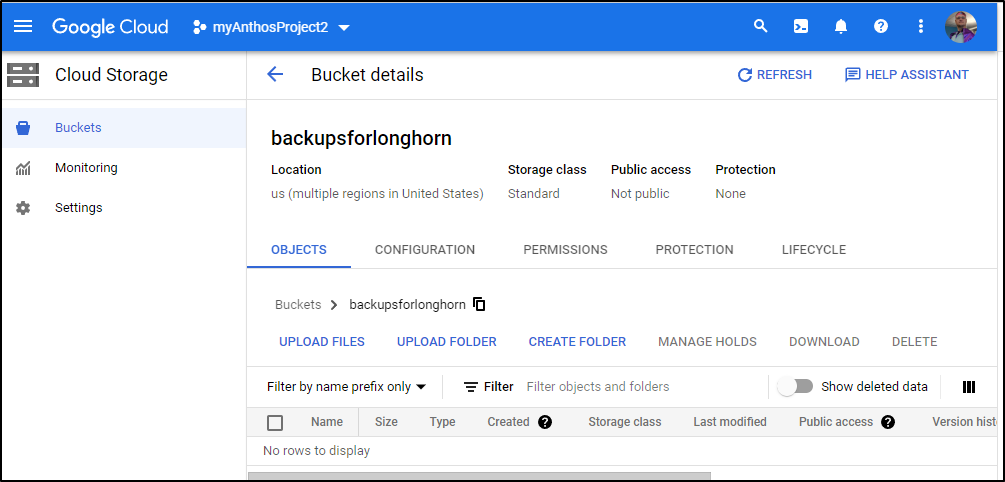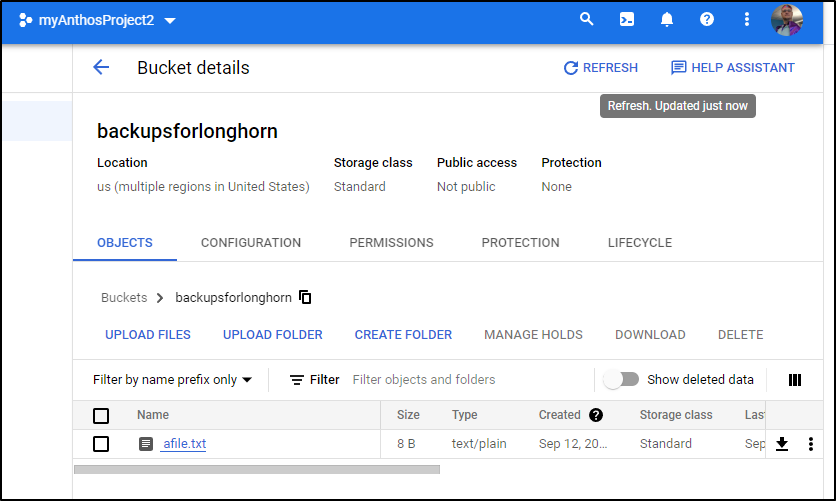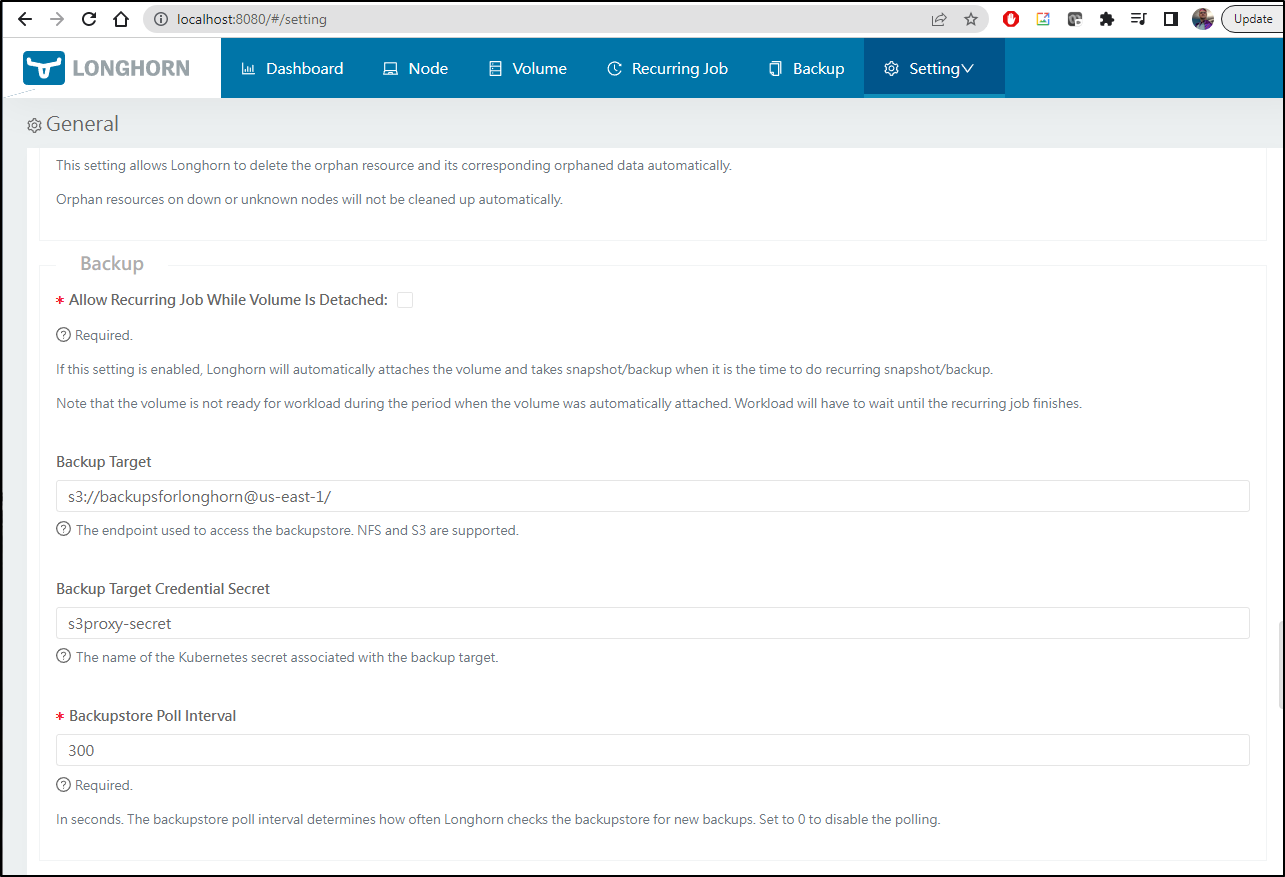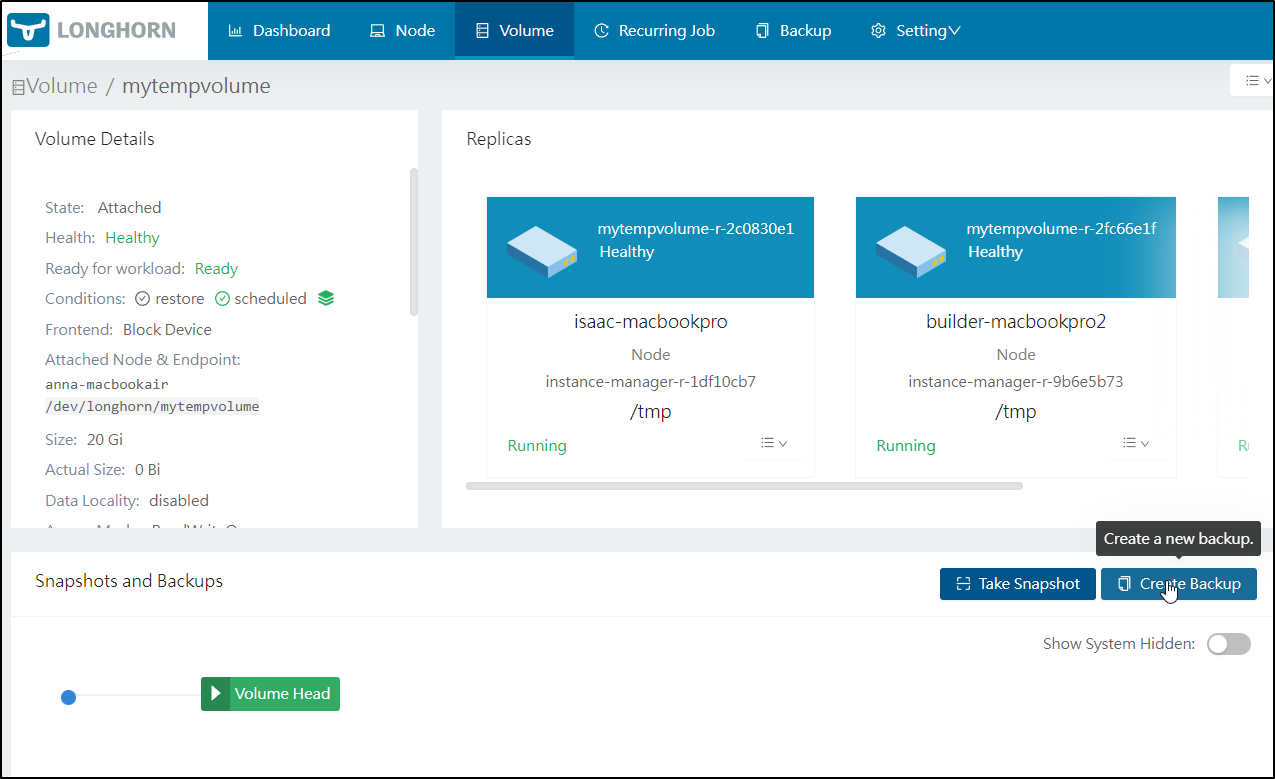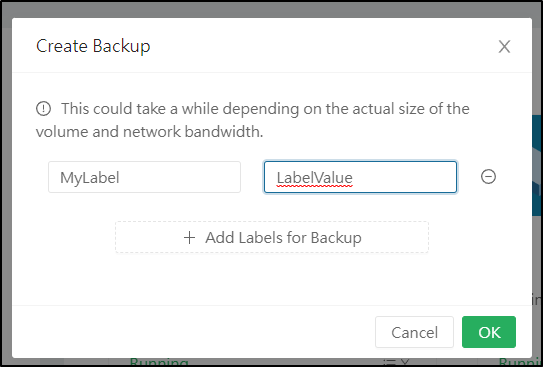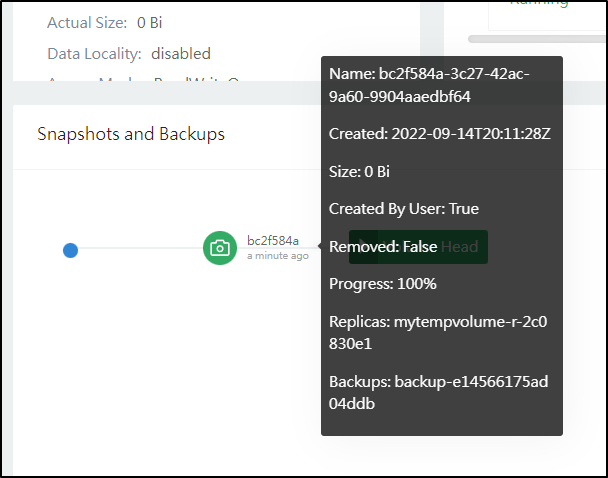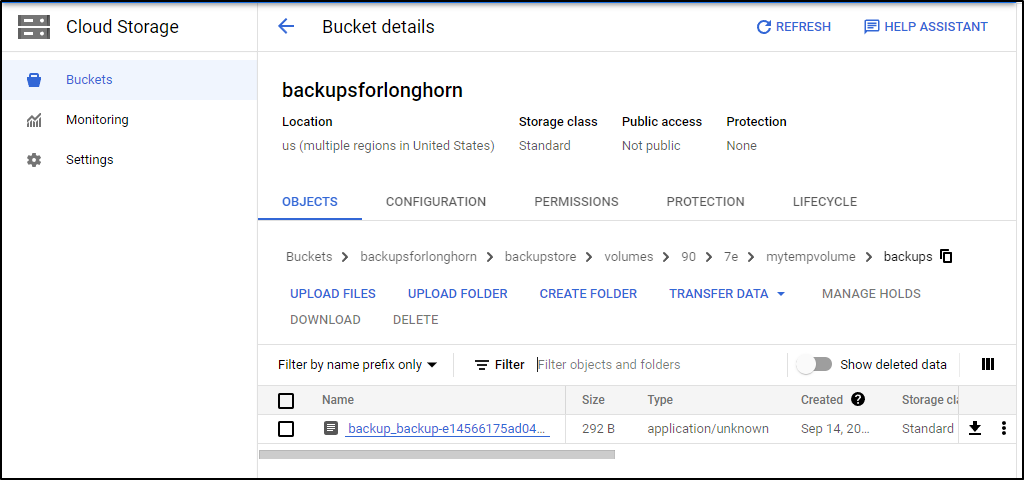Published: Sep 14, 2022 by Isaac Johnson
Today we’ll dig into some more ways we can leverage Cloud Storage to back our on-prem Kubernetes Persistent Volumes (and Persistent Volume Claims). I’ll cover GCP and more using a few different methods including Longhorn.io and S3Proxy.
GCFuse
Let’s first try to mount a bucket using Fuse.
I’ve already started the work to build out a k3s reload and prep playbook
---
- name: Reload K3s
hosts: all
tasks:
- name: Install Python3
ansible.builtin.shell: |
whoami
pwd
args:
chdir: /tmp
- name: Install Python3
ansible.builtin.shell: |
apt-get install -y python3 python3-venv python3-pip
become: true
args:
chdir: /tmp
- name: Install Cifs and iscsi
ansible.builtin.shell: |
apt-get install -y cifs-utils open-iscsi
become: true
args:
chdir: /tmp
- name: Add AWS CLI
ansible.builtin.shell: |
apt-get install -y awscli s3fs
args:
chdir: /tmp
I’ll add a new section for gcfuse and run the playbook
- name: Install GCP Fuse
ansible.builtin.shell: |
export GCSFUSE_REPO=gcsfuse-`lsb_release -c -s`
rm -f /etc/apt/sources.list.d/gcsfuse.list || true
echo "deb http://packages.cloud.google.com/apt $GCSFUSE_REPO main" | sudo tee /etc/apt/sources.list.d/gcsfuse.list
curl https://packages.cloud.google.com/apt/doc/apt-key.gpg | sudo apt-key add -
apt-get update
apt-get install -y gcsfuse
become: true
args:
chdir: /tmp
Create bucket and creds
I’ll need to login to gcloud with the CLI.
I still get a kick out of the X11 based Firefox that launches due to Windows 11 supporting X
I can now see that I have no buckets
builder@DESKTOP-QADGF36:~$ export PROJECTID=myanthosproject2
builder@DESKTOP-QADGF36:~$ gcloud alpha storage ls --project=$PROJECTID
ERROR: (gcloud.alpha.storage.ls) One or more URLs matched no objects.
which matches what I see in the GCP cloud console
I can then create a bucket
$ gcloud alpha storage buckets create gs://myk3spvcstore --project=$PROJECTID
Creating gs://myk3spvcstore/...
$ gcloud alpha storage ls --project=$PROJECTID
gs://myk3spvcstore/
and see it listed in the Cloud Console (so I know I got the project correct)
Create SA and Keys
Now that we have a bucket, to use it we’ll need to create a service account we can use
$ gcloud iam service-accounts create gcpbucketsa --description "SA for Bucket Access" --display-name="GCP Bucket SA" --project=$PROJECTID
Created service account [gcpbucketsa].
Then grant it the storage admin role so it can interact with our buckets
$ gcloud projects add-iam-policy-binding $PROJECTID --member="serviceAccount:gcpbucketsa@$PROJECTID.iam.gserviceaccount.com" --role="roles/storage.admin"
Updated IAM policy for project [myanthosproject2].
bindings:
- members:
- serviceAccount:service-511842454269@gcp-sa-servicemesh.iam.gserviceaccount.com
role: roles/anthosservicemesh.serviceAgent
- members:
- serviceAccount:service-511842454269@gcp-sa-artifactregistry.iam.gserviceaccount.com
role: roles/artifactregistry.serviceAgent
- members:
- serviceAccount:service-511842454269@compute-system.iam.gserviceaccount.com
role: roles/compute.serviceAgent
- members:
- serviceAccount:service-511842454269@container-engine-robot.iam.gserviceaccount.com
role: roles/container.serviceAgent
- members:
- serviceAccount:service-511842454269@containerregistry.iam.gserviceaccount.com
role: roles/containerregistry.ServiceAgent
- members:
- serviceAccount:511842454269-compute@developer.gserviceaccount.com
- serviceAccount:511842454269@cloudservices.gserviceaccount.com
role: roles/editor
- members:
- serviceAccount:511842454269-compute@developer.gserviceaccount.com
role: roles/gkehub.connect
- members:
- serviceAccount:511842454269-compute@developer.gserviceaccount.com
- serviceAccount:service-511842454269@gcp-sa-gkehub.iam.gserviceaccount.com
role: roles/gkehub.serviceAgent
- members:
- serviceAccount:511842454269-compute@developer.gserviceaccount.com
role: roles/logging.logWriter
- members:
- serviceAccount:service-511842454269@gcp-sa-meshcontrolplane.iam.gserviceaccount.com
role: roles/meshcontrolplane.serviceAgent
- members:
- serviceAccount:service-511842454269@gcp-sa-meshdataplane.iam.gserviceaccount.com
role: roles/meshdataplane.serviceAgent
- members:
- serviceAccount:511842454269-compute@developer.gserviceaccount.com
role: roles/monitoring.metricWriter
- members:
- serviceAccount:service-511842454269@gcp-sa-multiclusteringress.iam.gserviceaccount.com
role: roles/multiclusteringress.serviceAgent
- members:
- serviceAccount:service-511842454269@gcp-sa-mcmetering.iam.gserviceaccount.com
role: roles/multiclustermetering.serviceAgent
- members:
- serviceAccount:service-511842454269@gcp-sa-mcsd.iam.gserviceaccount.com
role: roles/multiclusterservicediscovery.serviceAgent
- members:
- user:isaac.johnson@gmail.com
role: roles/owner
- members:
- serviceAccount:daprpubsub@myanthosproject2.iam.gserviceaccount.com
role: roles/pubsub.admin
- members:
- serviceAccount:service-511842454269@gcp-sa-pubsub.iam.gserviceaccount.com
role: roles/pubsub.serviceAgent
- members:
- serviceAccount:511842454269-compute@developer.gserviceaccount.com
role: roles/resourcemanager.projectIamAdmin
- members:
- serviceAccount:azure-pipelines-publisher@myanthosproject2.iam.gserviceaccount.com
- serviceAccount:gcpbucketsa@myanthosproject2.iam.gserviceaccount.com
role: roles/storage.admin
etag: BwXoPNtXGtE=
version: 1
Then we’ll need a key it can use for FUSE (and later s3Proxy)
$ gcloud iam service-accounts keys create ./sa-private-key.json --iam-account=gcpbucketsa@$PROJECTID.iam.gserviceaccount.com
created key [4c1asdfsadasdfsadfasdasasdf2c] of type [json] as [./sa-private-key.json] for [gcpbucketsa@myanthosproject2.iam.gserviceaccount.com]
We can see the details we will need in the file
$ cat sa-private-key.json | jq
{
"type": "service_account",
"project_id": "myanthosproject2",
"private_key_id": "4c1asdfsadasdfsadfasdasasdf2c",
"private_key": "-----BEGIN PRIVATE KEY-----\nMIIEstuff stuff stuff stuff stuff stuff stuff stuff stuff stuff stuff stuff stuff stuff stuff stuff stuff stuff stuff stuff stuff stuff stuff stuff stuff stuff stuff stuff stuff stuff stuff stuff stuff stuff stuff stuff stuff stuff stuff stuff stuff stuff stuff stuff stuff stuff stuff stuff stuff stuff stuff stuff stuff stuff stuff stuff stuff stuff stuff stuff stuff stuff stuff stuff stuff stuff stuff stuff stuff stuff stuff stuff stuff stuff stuff stuff stuff stuff stuff stuff stuff stuff stuff stuff stuff stuff stuff stuff stuff stuff stuff stuff stuff stuff stuff stuff stuff stuff stuff stuff stuff stuff stuff stuff stuff stuff stuff stuff stuff stuff stuff stuff stuff stuff stuff stuff stuff stuff stuff stuff stuff stuff stuff stuff stuff stuff stuff stuff stuff stuff stuff stuff stuff stuff stuff stuff stuff stuff stuff stuff stuff stuff stuff stuff stuff stuff stuff stuff stuff stuff stuff stuff stuff stuff stuff stuff stuff stuff stuff stuff stuff stuff stuff stuff stuff stuff stuff stuff stuff stuff stuff stuff stuff stuff stuff stuff stuff stuff stuff stuff stuff stuff stuff stuff stuff stuff stuff stuff stuff stuff stuff stuff stuff stuff stuff Q==\n-----END PRIVATE KEY-----\n",
"client_email": "gcpbucketsa@myanthosproject2.iam.gserviceaccount.com",
"client_id": "111234123412341234123412349",
"auth_uri": "https://accounts.google.com/o/oauth2/auth",
"token_uri": "https://oauth2.googleapis.com/token",
"auth_provider_x509_cert_url": "https://www.googleapis.com/oauth2/v1/certs",
"client_x509_cert_url": "https://www.googleapis.com/robot/v1/metadata/x509/gcpbucketsa%40myanthosproject2.iam.gserviceaccount.com"
}
Now we have a bit of an issue - I have a secret but my ansible playbooks are public. Clearly, I won’t save it in the playbook.
A quick solution is to base64 encode the file on my local workstation
$ cat sa-private-key.json | base64 -w 0
ewogICJ0eXBl........
Under Hosts, we’ll check the box for all, then click “run command”
I’ll then paste in the base64 string from above (where you see “thelongbase64stringhere”)
Then launch to see it decrypted onto the 3 hosts into the /tmp folder
I can check a host for sanity
$ ssh builder@192.168.1.81
Welcome to Ubuntu 20.04.4 LTS (GNU/Linux 5.15.0-46-generic x86_64)
* Documentation: https://help.ubuntu.com
* Management: https://landscape.canonical.com
* Support: https://ubuntu.com/advantage
12 updates can be applied immediately.
To see these additional updates run: apt list --upgradable
New release '22.04.1 LTS' available.
Run 'do-release-upgrade' to upgrade to it.
Your Hardware Enablement Stack (HWE) is supported until April 2025.
Last login: Fri Sep 9 07:03:50 2022 from 192.168.1.57
builder@anna-MacBookAir:~$ cat /tmp/sa-storage-key.json | jq | head -n3
{
"type": "service_account",
"project_id": "myanthosproject2",
I could automate the next steps, but I prefer to do fstab updates directly
builder@anna-MacBookAir:~$ cp /tmp/sa-storage-key.json /home/builder/
builder@anna-MacBookAir:~$ chmod 600 ~/sa-storage-key.json
builder@anna-MacBookAir:~$ sudo mkdir /mnt/gcpbucket1 && sudo chmod 777 /mnt/gcpbucket1
builder@anna-MacBookAir:~$ sudo vi /etc/fstab
builder@anna-MacBookAir:~$ cat /etc/fstab | tail -n1
myk3spvcstore /mnt/gcpbucket1 gcsfuse rw,noauto,user,key_file=/home/builder/sa-storage-key.json
builder@anna-MacBookAir:~$ sudo mount -a
mount error(115): Operation now in progress
Refer to the mount.cifs(8) manual page (e.g. man mount.cifs) and kernel log messages (dmesg)
dmesg provided
[725220.764420] kauditd_printk_skb: 1 callbacks suppressed
[725220.764424] audit: type=1400 audit(1662723333.575:68): apparmor="DENIED" operation="open" profile="snap.snap-store.ubuntu-software" name="/etc/PackageKit/Vendor.conf" pid=1107928 comm="snap-store" requested_mask="r" denied_mask="r" fsuid=1000 ouid=0
[725237.139454] audit: type=1400 audit(1662723349.946:69): apparmor="DENIED" operation="open" profile="snap.snap-store.ubuntu-software" name="/var/lib/snapd/hostfs/usr/share/gdm/greeter/applications/gnome-initial-setup.desktop" pid=1107928 comm="pool-org.gnome." requested_mask="r" denied_mask="r" fsuid=1000 ouid=0
[725237.191463] audit: type=1400 audit(1662723349.998:70): apparmor="DENIED" operation="open" profile="snap.snap-store.ubuntu-software" name="/var/lib/snapd/hostfs/usr/share/gdm/greeter/applications/gnome-initial-setup.desktop" pid=1107928 comm="pool-org.gnome." requested_mask="r" denied_mask="r" fsuid=1000 ouid=0
[725238.124161] audit: type=1326 audit(1662723350.934:71): auid=1000 uid=1000 gid=1000 ses=305 subj=? pid=1107928 comm="pool-org.gnome." exe="/snap/snap-store/558/usr/bin/snap-store" sig=0 arch=c000003e syscall=93 compat=0 ip=0x7f17c2b1d39b code=0x50000
[727245.148213] CIFS: Attempting to mount \\mac81azstoragecsi.file.core.windows.net\mycisstorage
[727255.471005] CIFS: VFS: Error connecting to socket. Aborting operation.
[727255.471022] CIFS: VFS: cifs_mount failed w/return code = -115
Ah, this is caused by my wunderbar ISP blocking 445 and me forgetting i left in my Azure storage mount. I’ll comment that out and try again
builder@anna-MacBookAir:~$ sudo vi /etc/fstab
builder@anna-MacBookAir:~$ sudo mount -a
builder@anna-MacBookAir:~$
Sadly, this did not work, no did any errors spew out.
Oddly, if I ran the same command directly, it mounted without error (could be “noauto” blocking it)
builder@anna-MacBookAir:~$ sudo mount -t gcsfuse -o rw,noauto,user,key_file=/home/builder/sa-storage-key.json myk3spvcstore /mnt/gcpbucket1
Calling gcsfuse with arguments: -o nosuid -o nodev --key-file /home/builder/sa-storage-key.json -o rw -o noexec myk3spvcstore /mnt/gcpbucket1
2022/09/09 07:20:21.638506 Start gcsfuse/0.41.6 (Go version go1.18.4) for app "" using mount point: /mnt/gcpbucket1
2022/09/09 07:20:21.667333 Opening GCS connection...
2022/09/09 07:20:22.080744 Mounting file system "myk3spvcstore"...
2022/09/09 07:20:22.092792 File system has been successfully mounted.
I could then touch a file
builder@anna-MacBookAir:~$ sudo touch /mnt/gcpbucket1/testing
and see it immediately reflected in the GCP Cloud Console
I must have typo’ed something because when I went to test on the next two hosts, it was fine
builder@DESKTOP-QADGF36:~/Workspaces/ansible-playbooks$ ssh builder@192.168.1.159
Welcome to Ubuntu 20.04.4 LTS (GNU/Linux 5.15.0-46-generic x86_64)
* Documentation: https://help.ubuntu.com
* Management: https://landscape.canonical.com
* Support: https://ubuntu.com/advantage
13 updates can be applied immediately.
To see these additional updates run: apt list --upgradable
New release '22.04.1 LTS' available.
Run 'do-release-upgrade' to upgrade to it.
Your Hardware Enablement Stack (HWE) is supported until April 2025.
Last login: Fri Sep 9 07:03:44 2022 from 192.168.1.57
builder@builder-MacBookPro2:~$ cp /tmp/sa-storage-key.json /home/builder/ && chmod 600 ~/sa-storage-key.json
builder@builder-MacBookPro2:~$ sudo mkdir /mnt/gcpbucket1
builder@builder-MacBookPro2:~$ sudo chmod 777 /mnt/gcpbucket1
builder@builder-MacBookPro2:~$ sudo vi /etc/fstab
builder@builder-MacBookPro2:~$ cat /etc/fstab | tail -n1
myk3spvcstore /mnt/gcpbucket1 gcsfuse rw,user,key_file=/home/builder/sa-storage-key.json
builder@builder-MacBookPro2:~$ sudo mount /mnt/gcpbucket1/
Calling gcsfuse with arguments: --key-file /home/builder/sa-storage-key.json -o rw -o noexec -o nosuid -o nodev myk3spvcstore /mnt/gcpbucket1
2022/09/09 07:26:25.162134 Start gcsfuse/0.41.6 (Go version go1.18.4) for app "" using mount point: /mnt/gcpbucket1
2022/09/09 07:26:25.180687 Opening GCS connection...
2022/09/09 07:26:25.650479 Mounting file system "myk3spvcstore"...
2022/09/09 07:26:25.662212 File system has been successfully mounted.
builder@builder-MacBookPro2:~$ sudo ls -l /mnt/gcpbucket1
total 0
-rw-r--r-- 1 root root 0 Sep 9 07:20 testing
and the other
isaac@isaac-MacBookPro:~$ sudo mount /mnt/gcpbucket1
Calling gcsfuse with arguments: -o noexec -o nosuid -o nodev --key-file /home/isaac/sa-storage-key.json -o rw myk3spvcstore /mnt/gcpbucket1
2022/09/09 07:31:18.296250 Start gcsfuse/0.41.6 (Go version go1.18.4) for app "" using mount point: /mnt/gcpbucket1
2022/09/09 07:31:18.312584 Opening GCS connection...
2022/09/09 07:31:18.747362 Mounting file system "myk3spvcstore"...
2022/09/09 07:31:18.755200 File system has been successfully mounted.
isaac@isaac-MacBookPro:~$ sudo ls -l /mnt/gcpbucket1
total 0
-rw-r--r-- 1 root root 0 Sep 9 07:20 testing
isaac@isaac-MacBookPro:~$
Longhorn
Now, as you might expect (and we covered in our last two blog entries), we can use Longhorn to expose this as a persistent volume class
$ helm install longhorn longhorn/longhorn --namespace longhorn-system --create-namespace --set defaultSettings.defaultDataPath="/mnt/gcpbucket1"
WARNING: Kubernetes configuration file is group-readable. This is insecure. Location: /home/builder/.kube/config
WARNING: Kubernetes configuration file is world-readable. This is insecure. Location: /home/builder/.kube/config
W0909 07:37:12.676674 30182 warnings.go:70] policy/v1beta1 PodSecurityPolicy is deprecated in v1.21+, unavailable in v1.25+
W0909 07:37:13.114282 30182 warnings.go:70] policy/v1beta1 PodSecurityPolicy is deprecated in v1.21+, unavailable in v1.25+
NAME: longhorn
LAST DEPLOYED: Fri Sep 9 07:37:11 2022
NAMESPACE: longhorn-system
STATUS: deployed
REVISION: 1
TEST SUITE: None
NOTES:
Longhorn is now installed on the cluster!
Please wait a few minutes for other Longhorn components such as CSI deployments, Engine Images, and Instance Managers to be initialized.
Visit our documentation at https://longhorn.io/docs/
Create a service (if you have not already) to forward traffic
$ cat longhornsvc.yaml
apiVersion: v1
kind: Service
metadata:
name: longhorn-ingress-lb
namespace: longhorn-system
spec:
selector:
app: longhorn-ui
type: LoadBalancer
ports:
- name: http
protocol: TCP
port: 80
targetPort: http
$ kubectl apply -f ./longhornsvc.yaml
service/longhorn-ingress-lb created
We can then port-forward to the service we created, and see 2.1Pi of storage we can use
$ kubectl port-forward svc/longhorn-ingress-lb -n longhorn-system 8080:80
We can also see longhorn as a storage class we can use with containers
$ kubectl get sc
NAME PROVISIONER RECLAIMPOLICY VOLUMEBINDINGMODE ALLOWVOLUMEEXPANSION AGE
local-path (default) rancher.io/local-path Delete WaitForFirstConsumer false 10d
rook-nfs-share1 nfs.rook.io/rook-nfs-provisioner Delete Immediate false 9d
s3-buckets aws-s3.io/bucket Delete Immediate false 8d
s3-existing-buckets aws-s3.io/bucket Delete Immediate false 8d
s3-existing-buckets2 aws-s3.io/bucket Delete Immediate false 8d
s3-existing-buckets3 aws-s3.io/bucket Delete Immediate false 3d
s3-existing-buckets4 aws-s3.io/bucket Delete Immediate false 3d
longhorn (default) driver.longhorn.io Delete Immediate true 3m35s
Testing
Under Volume, we can “create volume”
and give it a name and size. As it’s backend is GCP, we do not need to create replicas
I can now see a detached volume listed in Longhorn
As well as see it reflected in GCP Cloud Console
S3Proxy
We can now use that same sa json file to fire up S3Proxy to create an internal S3 endpoint we can use by Longhorn for backups OR as an s3 complaint storage medium.
$ cat s3proxy.yaml
apiVersion: v1
kind: Namespace
metadata:
name: s3proxy
---
apiVersion: v1
kind: Secret
metadata:
name: sa-storage-key
namespace: s3proxy
data:
sa-storage-key.json: ewo****base 64 of the Google SA JSON*****n0K
---
apiVersion: v1
kind: Service
metadata:
name: s3proxy
namespace: s3proxy
spec:
selector:
app: s3proxy
ports:
- protocol: TCP
port: 80
targetPort: 80
---
apiVersion: apps/v1
kind: Deployment
metadata:
name: s3proxy
namespace: s3proxy
spec:
replicas: 1
selector:
matchLabels:
app: s3proxy
template:
metadata:
labels:
app: s3proxy
spec:
volumes:
- name: sacred
secret:
secretName: sa-storage-key
containers:
- name: s3proxy
image: andrewgaul/s3proxy:latest
imagePullPolicy: Always
volumeMounts:
- mountPath: "/mnt/sacred"
name: sacred
readOnly: true
ports:
- containerPort: 80
env:
- name: JCLOUDS_PROVIDER
value: google-cloud-storage
- name: JCLOUDS_IDENTITY
value: gcpbucketsa@myanthosproject2.iam.gserviceaccount.com
- name: JCLOUDS_CREDENTIAL
value: /mnt/sacred/sa-storage-key.json
- name: S3PROXY_IDENTITY
value: mac81azstoragepremcsi
- name: S3PROXY_CREDENTIAL
value: S3l1wzS52sY4qbilPv8SrRKTTZEw1AbVljNnspxeaHvw8JpZdlW8A6og8ck5KF+6Wp2GYoF1i0Yn+AStjJJH4w==
Note: the S3Proxy Identity and Credential is rather arbitrary… just something we will use when connecting _to_ the S3Proxy service. Also, as we’ll see in a moment, we have to change some values to make this work
Then apply the above YAML
$ kubectl apply -f s3proxy.yaml
namespace/s3proxy unchanged
secret/sa-storage-key unchanged
service/s3proxy unchanged
deployment.apps/s3proxy configured
We can see that indeed the credential mounted as we would hope
$ kubectl exec -it s3proxy-6d7df87b6-mrx94 -n s3proxy -- /bin/bash
root@s3proxy-6d7df87b6-mrx94:/opt/s3proxy# ls /mnt/sacred/
..2022_09_10_10_56_09.236322181/ ..data/ sa-storage-key.json
root@s3proxy-6d7df87b6-mrx94:/opt/s3proxy# ls /mnt/sacred/sa-storage-key.json
/mnt/sacred/sa-storage-key.json
root@s3proxy-6d7df87b6-mrx94:/opt/s3proxy# cat /mnt/sacred/sa-storage-key.json
{
"type": "service_account",
"project_id": "myanthosproject2",
...
This will create a Proxy pod and service that we can use to direct s3 compatabile traffic to GCP Buckets
$ kubectl get pods -n s3proxy
NAME READY STATUS RESTARTS AGE
s3proxy-6d7df87b6-mrx94 1/1 Running 0 2d
$ kubectl get svc -n s3proxy
NAME TYPE CLUSTER-IP EXTERNAL-IP PORT(S) AGE
s3proxy ClusterIP 10.43.48.252 <none> 80/TCP 6d10h
To use this for Longhorn backups, we need to create a secret. To do this, we first need to base64 our secrets from the s3proxy definition above
$ echo S3l1wzS52sY4qbilPv8SrRKTTZEw1AbVljNnspxeaHvw8JpZdlW8A6og8ck5KF+6Wp2GYoF1i0Yn+AStjJJH4w== | tr -d '\n' | base64 -w 0 && echo
UzNsMXd6UzUyc1k0cWJpbFB2OFNyUktUVFpFdzFBYlZsak5uc3B4ZWFIdnc4SnBaZGxXOEE2b2c4Y2s1S0YrNldwMkdZb0YxaTBZbitBU3RqSkpINHc9PQ==
builder@DESKTOP-QADGF36:~/Workspaces/ansible-playbooks$ echo mac81azstoragepremcsi | tr -d '\n' | base64 -w 0 && echo
bWFjODFhenN0b3JhZ2VwcmVtY3Np
builder@DESKTOP-QADGF36:~/Workspaces/ansible-playbooks$ echo http://s3proxy.s3proxy.svc.cluster.local | tr -d '\n' | base64 -w 0 && echo
aHR0cDovL3MzcHJveHkuczNwcm94eS5zdmMuY2x1c3Rlci5sb2NhbA==
Now we can create and set the secret for Longhorn to use. Again, you see the base64 encoded values for ACCESS KEY ID and KEY match the above (and yes, even if your ACCESS_KEY looks like a b64 value, you b64 it again to make it a valid k8s secret)
$ cat longhornS3ProxySecret.yaml
apiVersion: v1
kind: Secret
metadata:
name: s3proxy-secret
namespace: longhorn-system
type: Opaque
data:
AWS_ACCESS_KEY_ID: bWFjODFhenN0b3JhZ2VwcmVtY3Np
AWS_SECRET_ACCESS_KEY: UzNsMXd6UzUyc1k0cWJpbFB2OFNyUktUVFpFdzFBYlZsak5uc3B4ZWFIdnc4SnBaZGxXOEE2b2c4Y2s1S0YrNldwMkdZb0YxaTBZbitBU3RqSkpINHc9PQ==
AWS_ENDPOINTS: aHR0cDovL3MzcHJveHkuczNwcm94eS5zdmMuY2x1c3Rlci5sb2NhbA== # http://s3proxy.s3proxy.svc.cluster.local
$ kubectl apply -f longhornS3ProxySecret.yaml
secret/s3proxy-secret created
However, we get errors
root@my-shell:/# aws s3 --endpoint-url http://s3proxy.s3proxy.svc.cluster.local ls
An error occurred () when calling the ListBuckets operation:
root@my-shell:/# aws s3 --endpoint-url http://10.43.48.252 ls s3://myk3spvcstore/
An error occurred () when calling the ListObjectsV2 operation:
root@my-shell:/# aws s3 --endpoint-url http://10.43.48.252 ls
An error occurred () when calling the ListBuckets operation:
root@my-shell:/# aws s3 --endpoint-url=http://s3proxy.s3proxy.svc.cluster.local ls s3://myk3spvcstore/
An error occurred () when calling the ListObjectsV2 operation:
The error we see from s3proxy matches what others have reported
</head>\n<body><h2>HTTP ERROR 400 chars /mnt/sacred/sa-storage-key.json doesn't contain % line [-----BEGIN ]</h2>\n<table>\n<tr><th>URI:</th><td>/myk3spvcstore</td></tr>\n<tr><th>STATUS:</t
After a lot of debugging and trial and error, I figured out the working syntax. It just wants the RSA key without any other decorations (but multi-line).
Here (with some masking) is my working s3proxy.yaml
apiVersion: v1
kind: Namespace
metadata:
name: s3proxy
---
apiVersion: v1
kind: Service
metadata:
name: s3proxy
namespace: s3proxy
spec:
selector:
app: s3proxy
ports:
- protocol: TCP
port: 80
targetPort: 80
---
apiVersion: apps/v1
kind: Deployment
metadata:
name: s3proxy
namespace: s3proxy
spec:
replicas: 1
selector:
matchLabels:
app: s3proxy
template:
metadata:
labels:
app: s3proxy
spec:
volumes:
- name: sacred
secret:
secretName: sa-storage-key
containers:
- name: s3proxy
image: andrewgaul/s3proxy:latest
imagePullPolicy: Always
volumeMounts:
- mountPath: "/mnt/sacred"
name: sacred
readOnly: true
ports:
- containerPort: 80
env:
- name: JCLOUDS_PROVIDER
value: "google-cloud-storage"
- name: JCLOUDS_ENDPOINT
value: "https://storage.googleapis.com"
- name: JCLOUDS_IDENTITY
value: "gcpbucketsa@myanthosproject2.iam.gserviceaccount.com"
- name: JCLOUDS_CREDENTIAL
value: |
-----BEGIN PRIVATE KEY-----
MIIEvAIBADANBgkq************************************************
****************************************************************
****************************************************************
****************************************************************
****************************************************************
****************************************************************
****************************************************************
****************************************************************
****************************************************************
****************************************************************
****************************************************************
****************************************************************
****************************************************************
****************************************************************
****************************************************************
****************************************************************
****************************************************************
****************************************************************
****************************************************************
****************************************************************
****************************************************************
****************************************************************
****************************************************************
****************************************************************
****************************************************************
*********************Q==
-----END PRIVATE KEY-----
- name: S3PROXY_IDENTITY
value: "mac81azstoragepremcsi"
- name: S3PROXY_CREDENTIAL
value: "S3l1wzS52sY4qbilPv8SrRKTTZEw1AbVljNnspxeaHvw8JpZdlW8A6og8ck5KF+6Wp2GYoF1i0Yn+AStjJJH4w=="
We can now test with an ubuntu pod
root@my-shell:/# aws s3 --endpoint-url=http://s3proxy.s3proxy.svc.cluster.local ls
1969-12-31 15:00:00 myk3spvcstore
I noticed “mb” (make bucket) did not work
root@my-shell:/# aws s3 --endpoint-url=http://s3proxy.s3proxy.svc.cluster.local mb s3://mybackups/
make_bucket failed: s3://mybackups/ An error occurred (BucketAlreadyOwnedByYou) when calling the CreateBucket operation: Your previous request to create the named bucket succeeded and you already own it. {BucketName=mybackups}
root@my-shell:/# aws s3 --endpoint-url=http://s3proxy.s3proxy.svc.cluster.local ls
1969-12-31 15:00:00 myk3spvcstore
root@my-shell:/# aws s3 --endpoint-url=http://s3proxy.s3proxy.svc.cluster.local mb s3://mybackups2/
make_bucket failed: s3://mybackups2/ An error occurred (BucketAlreadyOwnedByYou) when calling the CreateBucket operation: Your previous request to create the named bucket succeeded and you already own it. {BucketName=mybackups2}
root@my-shell:/# aws s3 --endpoint-url=http://s3proxy.s3proxy.svc.cluster.local ls
1969-12-31 15:00:00 myk3spvcstore
So I created one manualy in GCP Cloud Console
And then could see it with the CLI
root@my-shell:/# aws s3 --endpoint-url=http://s3proxy.s3proxy.svc.cluster.local ls
1969-12-31 15:00:00 backupsforlonghorn
1969-12-31 15:00:00 myk3spvcstore
I did a quick test of creating and uploading a small file
root@my-shell:/# echo "testing" > afile.txt
root@my-shell:/# aws s3 --endpoint-url=http://s3proxy.s3proxy.svc.cluster.local cp ./afile.txt s3://backupsforlonghorn/
upload: ./afile.txt to s3://backupsforlonghorn/afile.txt
And could see it reflected in GCP Cloud Console Bucket Storage Browser
Backups in Longhorn
We can port-forward to the longhorn service
$ kubectl port-forward svc/longhorn-ingress-lb -n longhorn-system 8080:80
Forwarding from 127.0.0.1:8080 -> 8000
Forwarding from [::1]:8080 -> 8000
Handling connection for 8080
Handling connection for 8080
Then go to settings and find the backups section. Here we use the s3bucket and the secret we created above
We can now Create a Backup of an existing volume using the s3proxy
Add any Labels
We can now see a backup
And I can now see my backup as routed from Longhorn through S3Proxy
Summmary
So we have done a few things here. We used GCFuse to mount a Google Cloud Storage bucket on a series of Kubernetes hosts, then used Longhorn.io to expose that mount as a Persistent volume class to our Kubernetes Cluster. Secondly, we used S3Proxy to expose another bucket as and S3 endpoint for Longhorn backups and successfully backed up a volume to Google Cloud Buckets.
The only struggle I found was figuring out the syntax of S3Proxy settings. They simply did not match the documentation and I could see others having similar errors.


